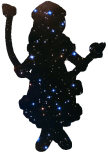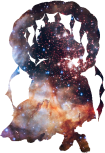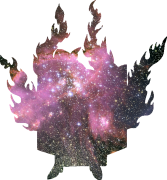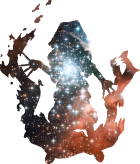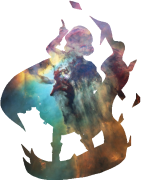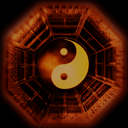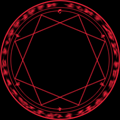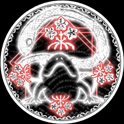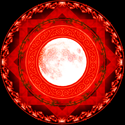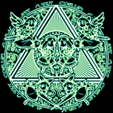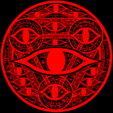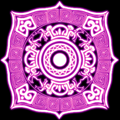The Mythologies That ZUN Loved
Shinto, Buddhism and Taoism have had a very profound influence on Japanese culture. Shinto represents the continuation and development of indigenous beliefs in Japan. Buddhism was once the dominant religion of the country, becoming deeply enmeshed into local beliefs and culture, even though it might have lost influence and power compared to it’s peak. Taoism was never really present as a large religious movement, yet quite widely influenced Japanese culture, spiritual practices as well as things like medicine and understanding of natural forces. These three religions and their influence on Japanese culture are also very much present in Gensokyo, and it’s this presence why I have chosen to exclude some other strands of Chinese influence – namely Confucianism – from this document.
There is a case to be made that the distinctions between these traditions in Japan are to some degree artificial, and could perhaps be more truthfully presented as a complex dance between indigineous and Chinese influences, as Taoism and wider trends in Chinese culture also influenced the forms of Buddhism which would arrive at Japan. In case of Japan, even the ”indigenous” is quite the hybrid of Asian, North Eurasian and Polynesian influences. That isn’t to deny Japan it’s existence as an unique culture, but rather to understand that the history of country has been much less insular than popular understanding would suggest.
However, treating the three traditions as separate things has value for analytical purposes. For better or worse, we certainly live in a world where people see these three as separate, albeit at times overlapping and hybridizing, things. Furthermore, I will do my best to point out how these three came together and influenced Japanese culture and folklore, giving rise to an unique culture.
While the indirect influence of these religions can be felt in many Japanese games, Touhou incorporates their presence in a surprisingly straightforward and whole way. It's not just singular references or things that kind of look or feel like things from these religions. Incorporating very real religions and especially their esoteric, magical side to a fantastic setting is something quite unique from a Western point of view. It would be very difficult for us to imagine a video game that wasn't some sort of historical strategy game that would feature religious conflict between Christianity, Islam and Judaism as a plot point. It would be even stranger to have a lighthearted game be about a conflict between Rosicrucians, Sufis and Kabbalists. In general, themes of religion tend to get downplayed or presented in very abstract, impersonal or fantasized ways in many Western games and works of popular fiction.
This shows how the Japanese have very different ideas about religion compared to the West. The country also has a tradition of gentle and humorous religious satire mostly about the rivalries of various Buddhist sects dating back to the medieval period. Japan also has a history of very real and bloody religious conflict and repression. As much as the religions present in Japan have inspired the culture, offered refuge, insight, beauty and deep appreciation into the surrounding world, they have also fostered corruption, strife, cults and been coaxed to serving imperialistic aims. All of these things come together in Touhou to create the unique depiction of these religions found in Gensokyo.
Touhou doesn't proselytize any religion, the print works often have quite a negative depiction of the practices of organized religion and ZUN's personal beliefs are largely unknown. The vivid, fascinating and magical depiction of these religions can however spark interest in them quite easily. If one starts digging deeper, they will find at the very least their understanding of Japanese and broader East Asian culture much deeper. For some, it could be the start of a lifelong transformative journey.
What Touhou however does do is that it taps in some rather deep trends and archetypes in Japanese culture. And these deep trends and archetypes were greatly shaped by the impact of these three traditions. Liminality, the focus on renewal, the ideas of impurity and purification, the idea of world being saturated with deities and strange spirits come from Japan’s indigenous traditions. Buddhism brought it’s own ideas about enlightenment, afterlife, salvation, the multiple planes of existence, the idea that certain people and beings could become awakened and thus also reach supermundane abilities – but also later frustration with corrupt practices of religious establishments entangled with earthly power. Daoism brought it’s view of world as a patterning of energy, and the idea that this energy could be understood and harnessed, up to the point of reaching immortality. It also brought many practical innovations like astrology, medicine and ritual technologies like the fulu talismans.
All of these ideas would roam around Japan’s cultural landscape, creating legends of men, deities and monsters, of miracles, mysteries and immortality elixirs. The paths woven by these ideas form the kind of popular periphery of these traditions. In every time, every place where some kind of spiritual traditions have emerged (so basicaly all of known human cultures) a kind of periphery and core have formed around them. The periphery is a kind of mythological, material and social layer. It’s the tales of men and monsters, of hells and heavens, myths of gods and goddesses, legends of people of note and miracles. It’s art, architechture, treasures, and the sense of belonging to a community. At the core of these traditions however is something that tried to reach to the very center of existence, something that makes the invisible visible and made people 2500-1000 years ago reach an understanding of the world that still feels fresh and relevant.
Touhou is of course largely about this periphery of legends. However, the periphery always points towards the core, and in case of Touhou there are moments of mythopoetical genius that seem entirely accidental. Gensokyo is a fantasy land which can be reached through the “gaps” of a powerful older woman. However, if you are not capable of dealing with spiritual hazards on the other side of these ”gaps”, you will “get eaten by youkai”. Take away the specifics, and these themes of spiritual power associated with (especially older) women, as well as terrifying hazards associated with being unable to live up to the challenge posed by spiritual forces, are about as old as time itself. This collusion of the desire and fear of other worlds, entities manifesting as members of the opposite sex, spirits and the potentially terrible consequences of becoming seduced by the numina when you are unready for the consequences are features still found in spiritual traditions up to this day.
In some ways Touhou feels almost like a shamanic work of art that is channeled, tapping into certain perennial themes as if by accident. In an interview, ZUN stated that ”the characters decide when they want to appear”. Much earlier, in the postscript of Symposium of Post-Mysticism he wrote of how he was surprised by the historical depth of his characters and how ”troublesome ones seemed to move on their own”. This all sounds more like channeling something than actively creating it. This sort of quality I believe can be sensed by others, even people who can’t really quite conceptualize it. This has given to semi-popular, quasi-serious theories and speculations such as Yakumo Yukari appearing to ZUN in person, or ZUN becoming spirited away as a child. The truth might be weird, but a bit less dramatic.
Other shamanic qualities in Touhou include things like the player characters being kind of spirit guide archetypes, travel to other worlds being a constant theme, Gensokyo’s hallucinatory geography, the Youkai Mountain acting as a kind of World Tree, the separation of Gensokyo from outside world by a “Barrier of Common Sense” and how from Unconnected Marketeers onwards the Outside World has been simply implied to be our world. Touhou’s strange unchanging, yet changing chronology, accessible even in the far future of the Hifuu Club and the stories' preference for exploration of different themes and mythologies over linear narratives are also shamanic qualities.
While popular imagination associated shamanism with Northern Eurasia and the Americas, shamanic traditions exist in Japan and helped shape the culture of the country. Even to this day hints of old shamanism can be found in Shinto, and the practices persist to this day in the fringes of society. In premodern times, various forms of spirit mediumship and exorcisms formed a notable part of folk spiritual practices. The history of Japanese spiritual traditions is ultimately one of beliefs, practices and legends escaping their context and confines and becoming intermingled.
It’s the history of people praying interchangeable to kami and buddhas while consuming traditional Chinese medicines, it’s village oracles chanting sutras to communicate with ancestral spirits, it’s yamabushi ascetics revering local deities as manifestations of buddhas while using mantras from Daoism and it’s buddhist deities escaping their mandalas and becoming centerpieces of popular faiths, attaining new characteristics in a wild mix of indigenous beliefs, Buddhism and Chinese influences.
As one could expect, at times the state authorities would crack down on these practices. Already in the 8th century the shamanistic miko were being put subject to regulations by the court. Medieval Buddhists produced polemics against folk practices deemd heretical and the Meiji reforms saw brutal forcible separation of Buddhism and Shinto, as well as a crackdown on ”supersitition”.
It’s this conflict between core and periphery, of orthodoxy and ”everything goes” that forms the last piece of Touhou’s shamanistic qualities and grand mythological themes. ZUN likes to contrast the aloof, out of touch, purity-obsessed Lunarians who idealize unchanging conditions with the wild, rough and earthly Gensokyo whose inhabitants are open to change. It’s easy to see that this not just as an ancient theme of order vs chaos, but also something reflecting Japanese history. And it’s no coincidence that the Lunarians heavily feature references to central figures of Shinto mythologies, while the inhabitants of Gensokyo are very much from the fringes.
Let’s then move onwards and begin our closer exploration of the traditions and mythologies that shaped Touhou.
